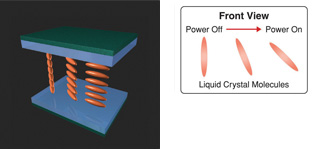Super Fine TFT Technology
Excellent viewing angle specifications
In LCD specifications the viewing angle refers to the maximum angle at which images can be viewed at an acceptable contrast ratio(*1), such as 10:1. This angle is expressed as degrees (from the line perpendicular to the center of the screen). Since the contrast ratio is the only defining factor for image quality, an LCD can claim an 80-degree viewing angle even if the colors look completely different than when viewed from the front. Moreover, images on two LCD panels with the same maximum viewing angle but different LCD drivers can look very different when viewed from an angle.

An LCD varies the amount of light passing through the screen by applying voltage to liquid crystal molecules sandwiched between two polarizing plates and by changing the alignment and direction of the molecules. Many LCDs apply voltage in the vertical direction, which rotates the liquid crystal molecules vertically. But SFT displays apply voltage in the horizontal direction, which rotates the molecules horizontally. The amount of rotation depends on the voltage level and is used to vary the amount of light penetration. When the liquid crystal molecules are fully horizontal, their size appears identical regardless of the angle from which they are viewed. The difference in brightness and color at different viewing angles is therefore smaller with SFT displays than with conventional LCDs.
(*1) The contrast ratio represents the contrast between the maximum brightness (white screen) and minimum brightness (black screen) in environments lacking any ambient light.

SFT is an abbreviation for Super Fine TFT.


